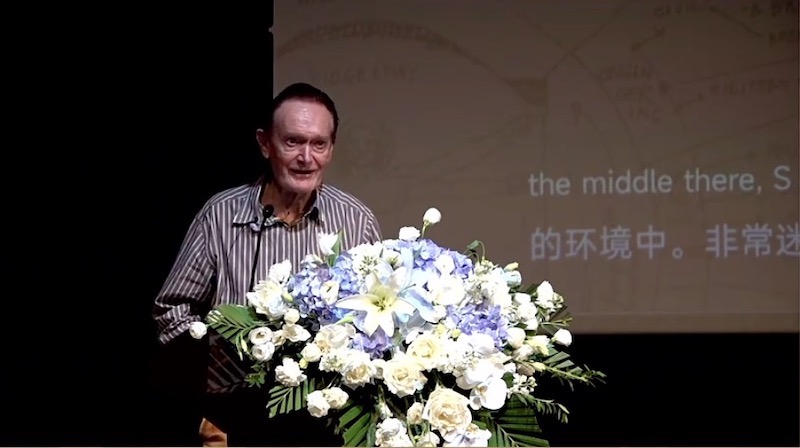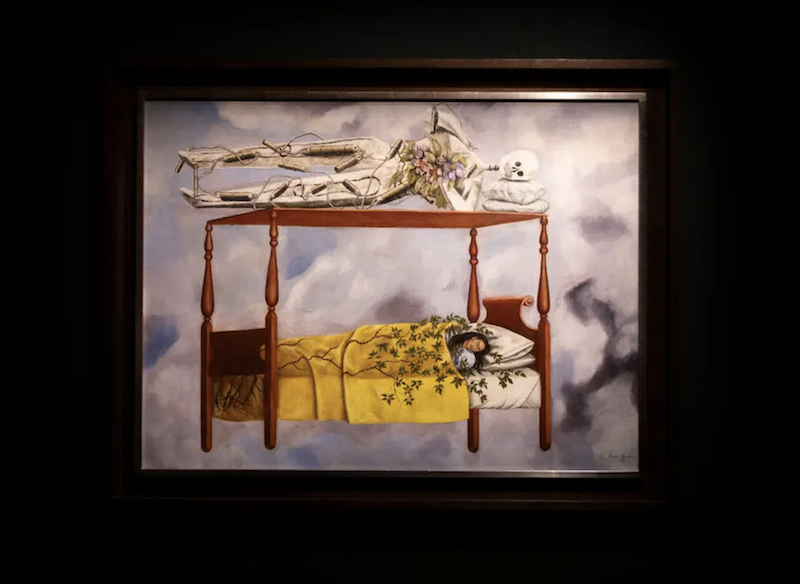
In the early 15th century, the invention of perspective provided artists with a technique grounded in optics for spatial measurement. Perspective became an essential "science," comparable to other liberal arts.
Recently, at a cultural event organized by the Gallery of Masterpieces, Martin Kemp, an Emeritus Professor of Art History at Oxford University, delivered a lecture titled “The Art of Perspective and Light in the Renaissance: From Brunelleschi to della Francesca,” exploring Brunelleschi’s invention of perspective and its artistic applications in the works of later artists like Piero della Francesca.

Martin Kemp, Emeritus Professor of Art History at Oxford University, at the Gallery of Masterpieces event
The inventor, discoverer, and promoter of optical mimicry in painting was none other than the renowned Filippo Brunelleschi—the architect of the Florence Cathedral, also known as the Dome of Santa Maria del Fiore. He utilized highly innovative structural techniques to construct the cathedral's remarkable dome. Brunelleschi was not just an architect but also an inventor who meticulously designed various machines and construction methods, embodying a hands-on practitioner.

Brunelleschi's design for the Florence Cathedral

Dome designed by Brunelleschi for the Florence Cathedral
However, during today’s lecture, Brunelleschi's most famous contribution was not the dome itself, but the linear perspective technique—although this assertion is somewhat misleading. He created two demonstration paintings that employed precise measurement methods to present buildings in three-dimensional form on a two-dimensional plane. Yet, these paintings were not standalone artworks; urban landscape paintings had no market in 15th-century Italy. His challenge was to realistically depict three-dimensional architecture in a two-dimensional medium using measurement techniques. According to his biographer Antonio Manetti, Brunelleschi produced two demonstration panels; one depicted the Piazza della Signoria in Florence, and the other, the Baptistery. While in Rome, he was accompanied by Donatello, who would go on to become a great sculptor. The two young men measured many classical buildings to understand their proportional relationships. During this process, Brunelleschi likely employed a technique that mapped the positions of objects onto a plane, illustrating how distant objects appeared farther away and how to accurately present this effect on a two-dimensional surface. It is almost certain that Brunelleschi made this discovery around 1413, yet there is scant evidence that painters utilized this technique in the following decade. His works were highly regarded and preserved as extraordinary achievements in the collection of the Medici family, but artists did not view this technique as a directly useful tool. After all, painters were more interested in showcasing depth through composition rather than simply depicting buildings with precise optical methods.
It is often said that Brunelleschi invented perspective, but more accurately, he developed a system for creating optical portraits of buildings. The term “perspective” derives from the Latin word prospectiva (optics), and it retains this meaning in Italian. Today, we typically associate perspective with painting, but at the time, it was considered an achievement in optics and science. Upon completing a painting, Brunelleschi drilled a small hole where the vertical lines of the artwork intersected with the vanishing point. He invited observers to look through this tiny aperture at a mirror that reflected the image of the Baptistery. Through this operation, he created a convincing and scientifically accurate architectural display that presented a realistic effect. This "Western mirror" had no connection to religious art, although some later interpretations attempted to link the two. At that time, it was purely an optical demonstration known as “prospettiva.”

The Baptistery

Illustration: Brunelleschi invited viewers to look through this small hole at a mirror that reflected the image of the Baptistery.
The first painter to master this technique was Masaccio, a friend and colleague of Brunelleschi in the 1420s. Masaccio played a pivotal role in applying these principles to the depiction of buildings. While Brunelleschi’s works were based on real structures, Masaccio, in a sense, did the opposite: he created the illusion of three-dimensional buildings on a flat surface. This is most famously exemplified in his fresco, “The Holy Trinity,” located in the Santa Maria del Carmine in Florence. The perspective in this painting creates a stunning visual effect, yet upon closer analysis, one can find an intriguing anomaly. If we adhere to the architectural norms of the Renaissance, the chapel's layout should be square, and therefore the grid on the ceiling should also be square. However, we observe that either these grids are slightly rectangular, or the chapel's layout is not perfectly square. How do we interpret this? In practice, when we view this painting, we do not notice these subtle discrepancies. We perceive the grids as square, and the chapel's layout as square, because Masaccio manipulated geometric structures to create visual harmony. His focus was not on mathematical precision, but rather on achieving unity within the composition.

Masaccio, “The Holy Trinity”
It can be said that Brunelleschi and Masaccio had not fully realized the complete concept of perspective as we understand it today. The true systematization of these rules came from Leon Battista Alberti, who described a perspective grid for accurately positioning objects in his 1435 treatise, On Painting.

Alberti's perspective grid for accurately positioning objects as described in On Painting

Alberti's perspective grid for accurately positioning objects as described in On Painting
The next generation of artists and sculptors began to grasp this idea in interesting ways. Among the leading figures was Lorenzo Ghiberti, famous for his doors of the Baptistery of Florence. His first set of doors was completed in 1424, with relief panels that incorporated Gothic quatrefoil framing while also blending Renaissance elements, continuing medieval traditions. However, the second set of doors, dubbed “The Gates of Paradise” by Michelangelo, marked a significant transformation. In this second set, Ghiberti translated sculpture into a painting-like form utilizing light and shadow. One of his renowned reliefs, “The Sacrifice of Isaac,” stands as a masterpiece of perspective. Ghiberti skillfully resolved the three-dimensional arrangement of objects; although aligning all elements was challenging, he exquisitely tackled the problems of perspective point and distance. This serves as an extraordinary example of Alberti’s perspective method perfectly realized in three-dimensional art.

Lorenzo Ghiberti, “The Sacrifice of Isaac”
Paolo Uccello was a pupil in Ghiberti’s workshop and one of the artists most curious and innovative about using perspective. Although he was not a sculptor, he certainly had a solid foundation in optics. Uccello was known for his clever use of perspective in narrative. One of his notable works is the predella painting, “The Miracle of the Desecration of the Host.” A predella is a small decorative panel at the bottom of an altarpiece, showcasing smaller stories or episodes related to the saintly narratives in the main painting. In this instance, while the main painting, “The Last Supper of the Apostles,” was created by Justus van Gent, Uccello likely contributed one of the small base paintings later in life. One of these small paintings demonstrates linear perspective perfectly.

Paolo Uccello's predella painting “The Miracle of the Desecration of the Host”

Paolo Uccello's predella painting “The Miracle of the Desecration of the Host” (detail)

Paolo Uccello's predella painting “The Miracle of the Desecration of the Host” (detail)
The Ashmolean Museum in Oxford houses Uccello’s painting “The Hunt in the Forest.” This work underwent analysis in Cambridge, revealing a hidden perspective grid beneath the surface. Uccello originally intended to depict a tiled floor within the painting to accurately arrange the positions of figures, horses, and hounds.

Paolo Uccello, “The Hunt in the Forest”
One of Uccello’s most famous works is the three-panel tempera painting “The Battle of San Romano,” now distributed among the National Gallery in London, the Uffizi Gallery in Florence, and the Louvre in Paris. These paintings depict the chaos of battle, yet every detail adheres to a certain optical order. For example, the alignment of spears in the background corresponds to the perspective grid, resembling a neatly laid tiled floor. I worked alongside visual analysis expert Antonio Criminisi to study this work, discovering that beneath the seemingly chaotic battle scene lay a structured arrangement similar to tiled flooring, all elements strictly adhering to optical rules. In one painting, the commander Niccolò da Tolentino points to his warhorse, wearing a uniquely shaped hat resembling a funnel, adding a distinctive flair. Amidst the chaos of battle, a soldier’s hat is knocked off, captured vividly in this moment. The poses of the soldiers, the fallen leaves on the ground, and the accents of trees all contribute to this dramatic scene, made possible through exquisite manipulation of perspective. Intriguingly, upon closer examination of certain elements' vanishing points, we can see they are, in fact, intertwined. This suggests that Uccello portrayed two different scenes within the same frame, differentiated by varying vanishing points. This represents a unique and effective narrative technique. Whether created by Uccello himself or his followers, these intricate compositions demanded immense patience and superb skill. Uccello's mastery of perspective enabled him to realize virtually any conceivable design in spatial representation. In 1992, during the celebration of the 500th anniversary of Columbus, we produced a film titled “Masters of Illusion,” examining the techniques of illusion in painting. I once showcased Uccello’s drawings from the 1440s to some Hollywood special effects experts, astonishing them. The wireframe technique Uccello employed is remarkably similar to modern computer graphics. The idea that such advanced techniques were utilized in the 15th century is indeed striking. In my opinion, Uccello is one of the greatest masters of perspective in history, even surpassing Da Vinci.
<
